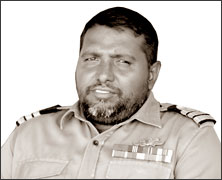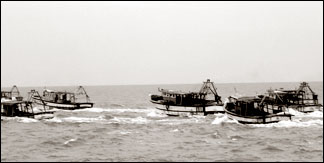Flotilla of Indian fishing trawlers dots Jaffna seas
Navy runs big risk sifting good from bad:
 by Ranil Wijayapala by Ranil Wijayapala
Date:18th June 2008
Location: SLN Wasaba, Delft Island
Time: 12 noon
|

Rear Admiral Thisara Samarasinghe, Commander, Northern Naval
Area. |
The
Navy officials at the radar room were observing the activities taking
place in the seas off the coast of Delft Island. Except for the echoes
indicating the Navy boats patrolling the sea they were beginning to
observe series of echoes on the radar screen. The echoes indicated in
the radar screen were well within the Lankan territorial waters. The
small dots started creeping into our waters.
As time passed the number of echoes started to increase in hundreds.
They were in clusters and the Navy officials’ eyes pivoted on the small
dots. “They are the Indian trawlers poaching in our seas,” Commander
K.K.K. Ananda, Commanding Officer of SLN Wasaba based at Delft Island
says. It has become a regular feature for him.

He then instructs his officials to put out small boats to monitor
what was happening out there, three to four kilometres off the coast at
a distance within eyesight.
|

Commander K.K.K. Ananda Commanding Officer, SLN Wasaba, Delft
Islands. |
Though it may appear to be a usual happening they cannot ignore it
lightly. The trawlers in clusters were trawling the Lankan waters to
catch bigger fish, and rich sea foods in the deep waters.
As the Navy boats close around the clusters they start to disperse,
with their hands raised and once cleared settle down to their usual
jobs.
The Sri Lanka Navy acts like diplomats in the sea. It is not a
question of one or two Indian trawlers; they have to deal with hundreds
of trawlers or even exceeding thousands crossing the International
Maritime Boundary Line between Sri Lanka and India after sailing from
the Southern coast of India.
There is no iota of doubt that they are breaching the international
maritime law crossing the IMBL and taking away the resources belonging
to another country which does not happen anywhere else in the world.
During the daytime Navy boats can search at least few boats which they
feel suspicious.
But it is an extremely difficult task for them to do it during night
hours. Anything could happen under the cover of the darkness.
|

Indian trawlers poaching Lankan waters, the local fishermen
fishing in shallow waters using non-mechanised boats. |
“They even dare to cross the sea corridor between Nainativu and the
Delft Island and even the sea channel between Pungudutivu and Nainativu
islands knowing that they were fishing well inside Lankan waters,”
Commander Ananda says.
“The scene in the night here is something like thousands of Vesak
lanterns floating in the sea”, Commander Ananda says. But it was not a
simple matter of comparing it with Vesak lantern.
These Indian trawlers have placed the Sri Lankan Navy into a helpless
situation. The Navy could easily tackle the situation if it was a matter
of two or three trawlers.
They can easily shoot at the Indian trawlers as they have clearly
breached the law of the land by illegally entering the Lankan waters or
they can arrest the trawlers and the fishermen and put them in prisons
for years. But it has become an issue relating to the goodwill of two
neighbouring countries.
No country would tolerate when hundreds of their citizens come under
attack from a foreign Navy. In the same manner it is extremely difficult
for any Navy to observe their resources being taken away by citizens of
another country in front of their own eyes.
Though these type of things are not expected to happen anywhere in
the world it is practically happening in Lankan waters while the Lankan
Navy is observing a high level of patience just to keep the goodwill of
its great neighbour. No one would believe this until they observe what
is unfolding there with their own eyes.
The great irony behind this issue is that the Lankan Navy had to
observe this situation not only off the coast of Jaffna islands but also
off the coast of Talaimannar while imposing bigger restrictions on the
local fishing community restricting their fishing areas just to one
kilometre stretch from the coast, for non-mechanized boats in the
interest of national security.
Under these circumstances the local fishing community who had to
satisfy with small baskets of fish had to observe the way their Indian
neighbours taking boat loads of fish from their lucrative fishing
grounds.
Set aside the issue of exploiting our lucrative fishing grounds, the
issue of Indian trawler has reached to an alarming level at this
juncture paving the way to put the national securities of the two
countries at peril with the North East conflict had reached to a
decisive phase with successful ground operations being conducted in the
Wanni confining the LTTE into a limited area in the Kilinochchi and
Mullaitivu districts.
If someone questions as to how the LTTE is facing the troops with
greater strength of fire power even after Navy destroying ten ships an
answer to this question can be easily given with this scene of Indian
trawlers in hundreds poaching the Lankan waters.
The LTTE can easily depend on their fuel need and also explosives,
arms and ammunition smuggling them to the shores mingling with these
fishing trawlers. Therefore, the efforts taken by the Sri Lankan Navy to
starve the LTTE of arms and ammunition.
Apart from the fact that Indian fishing trawlers are giving an
opportunity to the LTTE to exploit the situation in their favour not
only in Sri Lanka but also in Tamil Nadu politics.
The LTTE used all their tactics to put the blame to antagonize Indian
authorities against Sri Lanka Navy after attacking the Navy taking the
cover of the Indian trawlers poaching Lankan waters.
It was after practising greater level patience by the Sri Lanka Navy
could clear its name and proves the fact that it was the LTTE who had
unleashed violence against the Indian fishermen not by the Navy.
The concern of the Sri Lanka Navy has also focused a greater risk on
the security of the Jaffna peninsula due to the presence of large number
of Indian fishing trawlers in and around Jaffna islands at a time
Security Forces receiving intelligence reports regarding a possible
Tiger attack on Jaffna peninsula.
The greater risk involving fishing trawlers should be highlighted as
possibilities are very high for the LTTE to launch massive attack
involving hundreds of suicide boats. The presence of hundreds of fishing
trawlers in Lankan waters hampers the possibility of identifying such
suicide boats out of these trawlers in order to foil such LTTE attempts.
The gravity of this problem deepens if LTTE take these Indian
fishermen as hostages and drive them into Navy boats, no one predict to
what extent the consequences of such attack would affect the ongoing
conflict.
No body can give assurances or guarantees on this issue due to the
unpredictable nature of the LTTE and also due to their capability to
risk the lives of innocent civilians.
In the present days context possibilities are very high for the LTTE
to go for a do or die attack risking even thousands of innocent lives.
Recent intelligence reports have also indicated that the LTTE had
given instructions to their cadres to achieve their objective of
launching major assault on Jaffna peninsula risking even hundreds of
Tamil civilians.
The Tiger outfit displayed its total disregard towards Tamil civilian
during the recent attack on the Cheerativu island located by the side of
the Panway causeway connecting the Mandathivu Island with the Jaffna
town.
During this attempt they launched artillery attack on Colombuthurai
fishing village disregarding the civilian population living there.
Therefore, the Security Forces are now much more concerned about the
Security of the Jaffna islands as possibilities are very high for the
LTTE make use of these islands as launching pad for a massive attack on
the Jaffna peninsula due to the easy accessibility from K Point in
Pooneryn and also from Vedithalthivu area.
The Tiger outfit which is keenly waiting for massive international
involvement to stop the military thrust on them will be able to get
massive Indian involvement if they can make use of these Indian fishing
trawlers as a shield to launch this attack on Jaffna.
Therefore, this sensitive issue relating Indian trawlers poaching Sri
Lankan waters has become the most sensitive topic between the two
countries. This issue has been raised each and every forum where matters
related to India and Sri Lanka is discussed.
Most recently the issue was raised at the biannual International
Maritime Boundary Line meeting held between Indian and Sri Lankan Naval
authorities on board the Indian ship INS Kirch on June 05. It was
represented by senior Navy officials from both countries.
Commander of the Northern Naval Area Rear Admiral Thisara
Samarasinghe, the Navy official directly facing the issue of Indian
trawlers made an impressive representation at this meeting to enlighten
the gravity of this problem to the Indian Naval and Coast Guard
officials.
 What is much worrying factor for the Lankan Navy officials is the
lack of monitoring system by the Indian Navy and the Coast Guard on
these fishing trawlers launched from the Tamil Nadu coast. Therefore,
ample opportunities are available for these fishermen to transport
explosives or weapons on board these fishing trawlers to be transferred
to the hands of the LTTE. What is much worrying factor for the Lankan Navy officials is the
lack of monitoring system by the Indian Navy and the Coast Guard on
these fishing trawlers launched from the Tamil Nadu coast. Therefore,
ample opportunities are available for these fishermen to transport
explosives or weapons on board these fishing trawlers to be transferred
to the hands of the LTTE.
“This is a very very dangerous situation concerning the national
securities of both countries”, Rear Admiral Thisara Samarasinghe says.
The lack of a mechanism on the part of the Indian Coast Guard and the
Indian Navy to monitor the fishing trawlers launched from the Tamil Nadu
coast was the main factor that hindered the process of controlling
Indian fishing boats.
“But there was a positive response from the Indian side towards this
which has become a real threat to our national security at this
juncture,” Rear Admiral Samarasinghe says.
Therefore, Sri Lanka Navy is very keen that the issue relating to
Indian trawlers poaching Lankan waters will be resolved amicably not
allowing the LTTE to take the upper hand of the North East conflict
which is now heading towards the most decisive phase in the two and half
decade history.
Pix: Rukmal Gamage
|
